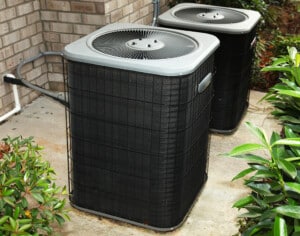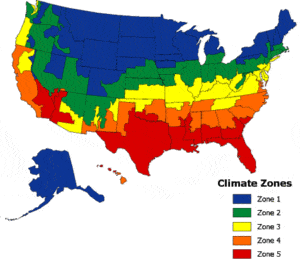
How to Choose the Right Size HVAC System for Your Home
It’s important to buy the correct size HVAC system for your log home. While homes have become more efficient over the years, with better insulation and double-hung windows, it would be incorrect to assume that installing the proper HVAC unit is any less important. Only the right size unit will keep your family comfortable while at the same time running efficiently.
It may come as a surprise to some, but when it comes to installing HVAC systems, bigger is not always better. A unit that is too large requires more energy, may produce uncomfortable temperature swings, and may not rid your home of excess humidity. Plus, it is more expensive to install. An HVAC system that is too small will not cool your home to a comfortable temperature. It will have to work longer and harder, resulting in added costly repairs and a shorter life for your HVAC unit.
When deciding on the best size HVAC system for your new log home, there are many things to consider, such as the climate in your area, the type and quantity of doors and windows in your home, and the number of people living there. Here are a few things to take into account before you buy your HVAC system:
Square footage of your log home
It goes without saying (but we’ll say it anyway) that the larger your home, the larger the HVAC system needs to be. You need to determine the square footage of your home as another means of deciding on the correct size HVAC system. If your home is under construction, you should be able to determine the square footage by looking at the blueprints. If your home is already built, you can simply measure each room (width times length) and add all the room measurements together.
Be sure to take into account all of the open cathedral areas, too. It is important to remember: the higher the ceiling, the larger your HVAC unit should be.
Outdoor temperatures
Once you know the square footage, think about how hot the summers will be in the area in which you are building your log home. The graph below shows United States broken into zones, depending on summer temperatures. For example, by looking at this graph, you can see that if you live in Zone 2 and are building a 2000-square-foot home, you should look at getting a 3.5-ton unit. If you were to build the same log home in Zone 5, however, you could go with a smaller, 3-ton unit.
 This graph is a good place to look, but it doesn’t give us the entire picture. There are still other things to consider.
This graph is a good place to look, but it doesn’t give us the entire picture. There are still other things to consider.
Types, quantities, and locations of doors and windows
Windows and doors will have a dramatic impact on the size HVAC system you will need. It is estimated that 30% to 40% of your system’s cooling load can be attributed to solar gain through windows. That’s a significant percentage!
When choosing your windows and doors, think about which side of your house they will be located (south side vs. north side, etc.). Purchase good quality, energy efficient windows with U-values and that are appropriate for their location on your home. Also, think about the number of windows and doors your home will have. Again, it goes without saying, but the greater number of doors and windows, the larger your HVAC system should be.
It is also worth mentioning that eves and overhangs will help your home be more energy efficient, so consider those items as well.
Insulation
Think about the amount and quality of the insulation in your walls and ceiling. This is another area of your home where quality counts! A minimum R-22 in the walls and R-50 in the attics is recommended. Also, high-density batts or blow-in insulation is best for maximum energy efficiency. Better insulation means less work for your HVAC unit. This translates into fewer costly repairs and hassles for you, the homeowner.
Ductwork
The ductwork in your home should be carefully planned so that a minimum amount of ductwork can be run. This is another instance in which utilizing the correct size HVAC system is important. If you choose the correct HVAC system, you will most likely be able to reduce not only the amount of ductwork used but also the size of the ducts throughout your home. This reduction in total airflows will help your HVAC—and your home—run at its peak.
Building and roofing materials
Since you are building a log home, you are already one step ahead of the game. Logs homes are quite energy efficient structures. Wood is a natural insulator, as each log has millions of air pockets, which work to block heat transfer both into and out of the home. So, give yourself a pat on the back for making such a wise choice!
The type of roofing material you choose will have a big impact on how hard your HVAC system will have to work. You may opt for a “cool roof,” which uses material designed to reflect more sunlight and absorb more heat than traditional roofing materials. Cool roofs can be made using highly reflective paints, tiles, or shingles. Installing a cool roof can lower the roof temperature by as much as 50 degrees. Even metal roofing can be energy efficient, as it reflects much of the sunlight that would otherwise sink into your home.
Whichever roofing material you choose, go with the highest quality, most energy efficient type you can afford. It will save you a significant amount of money in the long run.
The number of people living in your home
As living beings, we each give off our own heat. (Some of us may be more full of hot air than others, but who are we to judge?!) When deciding on the right size HVAC for your home, count the number of people who will normally be living in the house. Multiply this number by 400, and that will tell you the approximate amount of BTUs (British Thermal Units) your family will contribute.
While this factor may seem insignificant, it is another item to consider when looking at the “big picture.” All items should be taken into account to get the most accurate idea of correct HVAC size.
If you’re the type of person who likes playing with numbers, check out www.loadcalc.net. Here, you’ll find the Whole House Online Load Calculator. Just by plugging in some numbers, this site can help you determine the size HVAC system you will need.
Of course, the best idea is to ask a professional. Talk to your builder or a licensed contractor. Their knowledge and experience can save you lots of time and frustration. And, after all, isn’t that what you’re paying them for?
Americans spend over $40 billion each year to heat and cool their homes. That’s a sixth of all the electricity generated in this country! With proper planning and the right choices, you can do your part to save both money and energy, and be more comfortable in the process. That is what we call a “win-win!”


